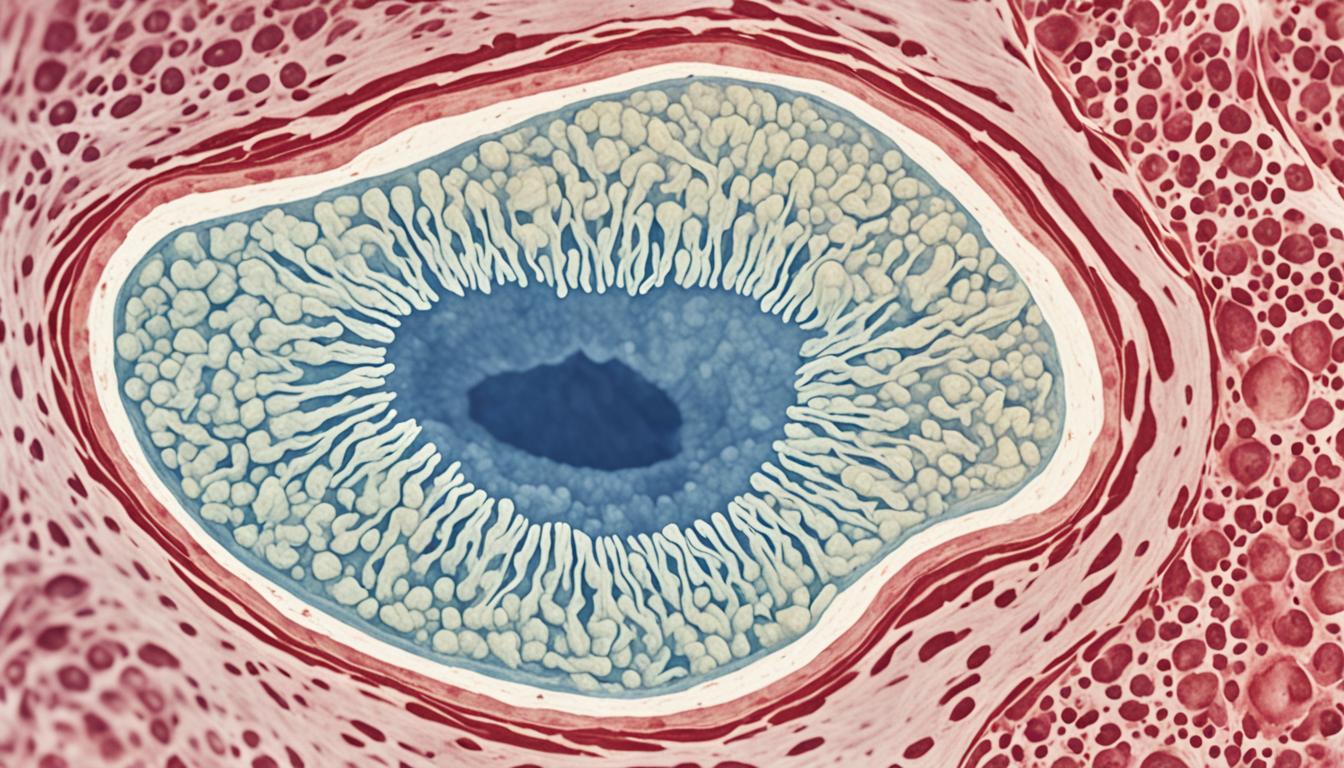Soft tissue sarcoma is a type of cancer that starts in different soft tissues of the body. These can be in the muscle, fat, fibrous tissue, or even blood vessels. Tumors from this cancer form lumps or swelling, which are the main signs. They appear mostly in the arms, legs, chest, or abdomen.
This disease is rare, making up only about 1% of adult cancers and 15% of children’s cancers. In the US, about 12,750 new cases are expected this year. Unfortunately, it’s predicted to cause 5,270 deaths in 2019.
Key Takeaways:
- Soft tissue sarcoma starts in the muscle, fat, fibrous tissue, or blood vessels.
- Signs often include lumps or swelling in affected areas.
- It’s a rare cancer type, accounting for 1% of adult cases and 15% of children’s cases.
- About 12,750 new cases are expected in the US this year.
- Early detection and the right treatment are essential for dealing with this cancer.
Types of Soft Tissue Sarcoma and their Symptoms
There are many types of soft tissue sarcoma. They affect various tissues and body parts. Knowing the types is key for correct diagnosis and treatment. Let’s look at the common types and their symptoms.
Angiosarcoma
Symptoms: Angiosarcoma targets blood or lymph vessels. Look out for red or purple skin patches, swelling, and unusual bumps.
Gastrointestinal Stromal Tumor (GIST)
Symptoms: GIST impacts a part of the digestive system. Signs include stomach pain, bleeding inside, anemia, and losing weight without trying.
Liposarcoma
Symptoms: Liposarcoma starts in fat cells. Watch for a soft, painless lump under your skin or in your muscles. It might get bigger and hurt over time.
Leiomyosarcoma
Symptoms: This type affects soft muscles in organs. You might feel pain, see swelling, or notice a lump in the area.
Synovial Sarcoma
Symptoms: It begins in stem cells near joints. Expect joint pain, trouble moving it, and a lump near the joint.
Neurofibrosarcoma
Symptoms: Neurofibrosarcoma harms nerve coverings. It can cause pain, numbness, weakness, or lumps on nerves.
Rhabdomyosarcoma
Symptoms: Found in muscle, it can hurt or swell. You might see or feel a bulge, often in the head, neck, or limbs.
Fibrosarcoma
Symptoms: It affects connective tissue cells. Look for pain, a swollen lump, and a hard time moving the area.
Myxofibrosarcoma
Symptoms: Mainly hitting older adults’ connective tissue, lookout for a painless mass, swelling, and trouble moving it.
Mesenchymomas
Symptoms: These are rare and vary a lot. Signs might be pain, a swollen lump, or other unusual growths.
Vascular Sarcoma
Symptoms: It affects blood vessels. Watch for pain, swelling, larger blood vessels, and lumps.
Schwannoma
Symptoms: This type involves nerve tissues. You might feel pain, numbness, muscle weakness, or find a lump.
Kaposi’s Sarcoma
Symptoms: Kaposi’s sarcoma starts in the skin but can spread. Look for strange skin colors, internal bleeding, and breathing issues.
Bone Sarcoma
Symptoms: Osteosarcoma mainly affects bones in limbs or the pelvis. It often causes long-lasting pain and can form a visible lump.
If you notice any of these symptoms, see a doctor right away. Quick diagnosis and treatment can make a big difference for those with soft tissue sarcoma.
| Sarcoma Type | Associated Symptoms |
|---|---|
| Angiosarcoma | Red or purple patches on the skin, swelling, abnormal bumps or lumps |
| Gastrointestinal Stromal Tumor (GIST) | Abdominal pain, gastrointestinal bleeding, anemia, unintended weight loss |
| Liposarcoma | Soft, painless lump under the skin or deep within the muscles |
| Leiomyosarcoma | Pain, swelling, mass or lump in affected area |
| Synovial Sarcoma | Joint pain, limited range of motion, mass or lump near the affected joint |
| Neurofibrosarcoma | Pain, numbness, weakness, nodules or lumps along the nerves |
| Rhabdomyosarcoma | Pain, swelling, mass or lump in the muscles |
| Fibrosarcoma | Pain, swelling, visible lump, limited mobility |
| Myxofibrosarcoma | Painless lump or mass, swelling, limited mobility |
| Mesenchymomas | Pain, swelling, lump or mass |
| Vascular Sarcoma | Pain, swelling, visible expansion of blood vessels, lump or mass |
| Schwannoma | Pain, numbness, muscle weakness, palpable lump or mass |
| Kaposi’s Sarcoma | Purple or brown skin lesions, internal bleeding, difficulty breathing |
| Bone Sarcoma | Persistent pain, lump or swelling (optional) |
Diagnosis and Treatment of Soft Tissue Sarcoma
Doctors use a detailed method to diagnose soft tissue sarcoma. They start by looking at the symptoms and your medical history. Then, they check you physically. They might ask for X-rays, MRIs, CT scans, or PET scans to find the tumor’s type. They also do lab tests and a biopsy (https://www.webmd.com/cancer/what-is-cancer-biopsy), which means testing a piece of the tumor, to be sure.
After confirming the diagnosis, treatment begins. This can involve one or more surgeries to take out the tumor. Parts of the area around it might also be removed. If needed, radiation therapy can be used to kill any leftover cancer cells. Sometimes, chemotherapy is given to fight the cancer all over the body. For more serious cases, doctors might use certain drugs like olaratumab or pazopanib to target the disease more directly.
Deciding on the best treatment is based on different things like the cancer’s stage and grade, tumor size, and how much it has spread. Remember, the chances of getting better from soft tissue sarcoma can vary. The odds of living five more years after finding it are better for cancers that didn’t spread far. Over the years, treatments have gotten better. Now, more people can beat this cancer and live longer if it’s caught early and treated well.

